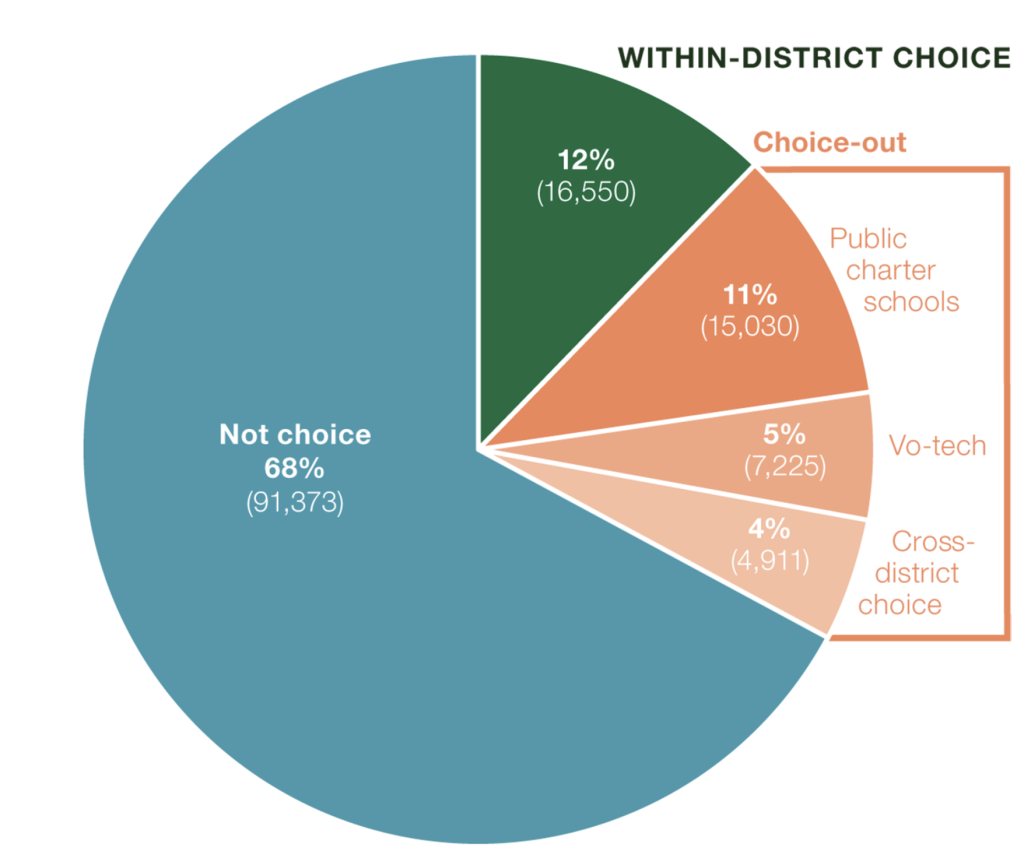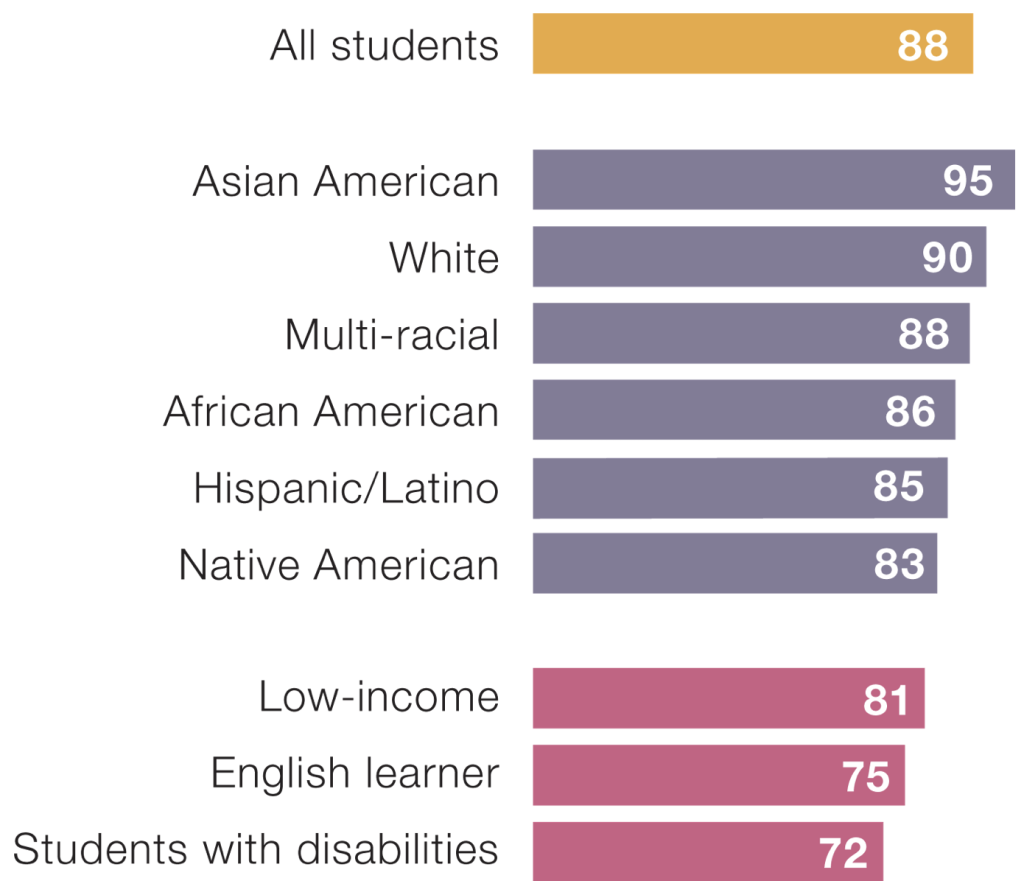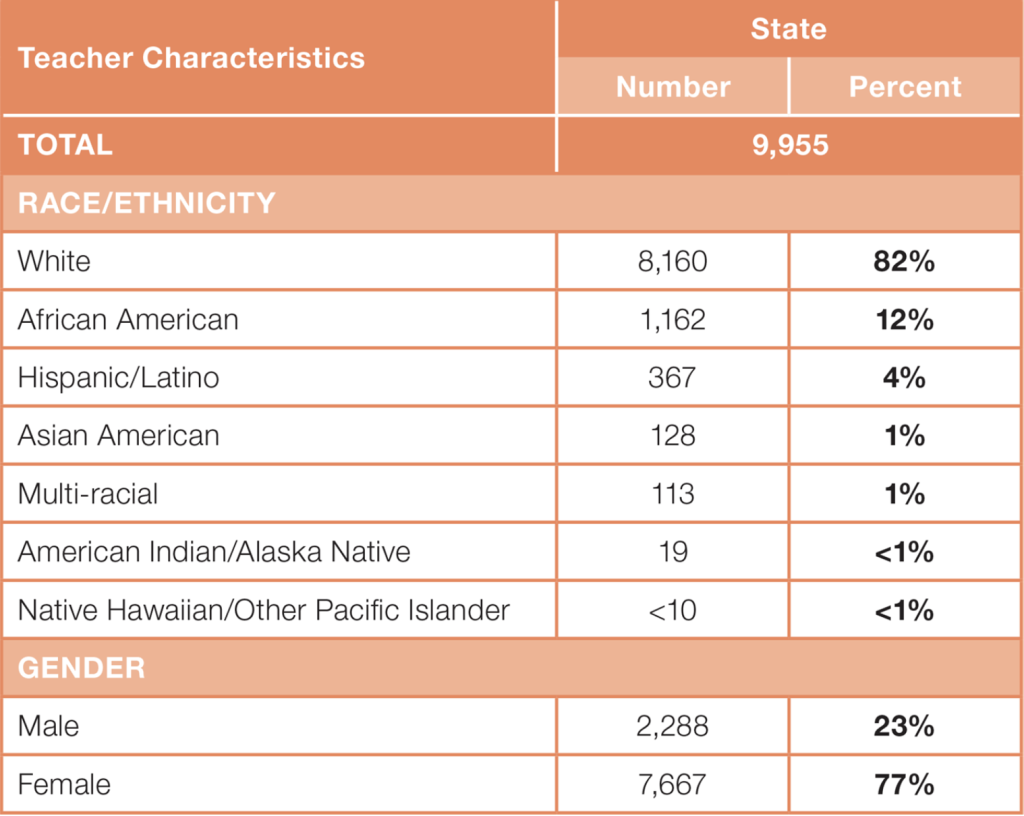Delaware Public Education at a Glance
 Grace Travis
Grace Travis
Student Enrollment
(Rodel, 2021)
Total Public School Population: 138, 414
By Demographics:
School Choice:

Public School Options (Choice Out) – 20%
NonPublic School Options – 12%
Students Attending Resident School – 68%
Analysis: While student enrollment has decreased from previous years, a trend attributed to the pandemic, Delaware public schools have seen a significant increase in certain student demographics. Since the 2011-12 school year, the Hispanic/Latino population has increased more than 48% as the White student enrollment has decreased by around 9%. Additionally, over the last decade, Delaware school have received an influx of students with disabilities and English language learners. These populations have increased by 26% and 92% respectively. Looking at enrollment trends by school type, enrollment in the traditional public school has remained constant over the last decade while enrollment in non-public schools has steadily decreased but increased significantly in public charter schools. The state of Delaware does not have a voucher program but they do have unrestricted open enrollment (Delaware School Choice Roadmap, 2022). This means that a child is able to attend any public school in Delaware regardless of where they live or where the school is located. With 215 public schools, 23 charter schools, 6 vocational technical schools, and 3 magnet schools, it is not surprising that private school enrollment has decreased as tuition for private schools has increased. However, one barrier that remains in the open enrollment policy is that transportation to and from school is not provided for those who chose to participate.
College and Career Readiness
(Rodel, 2021)
Average SAT English Language Arts Proficiency: 48%
Average SAT Math Proficiency: 28%
By Demographics (Percentage of students scoring at or above grade level on the SAT):

Adoption of Common Core: 2010
Adoption of Next Generation Science Standards: 2013
Average Graduation Rate: 88%
By Demographics:

College Enrollment: 57%
Analysis:
The trends in both English and math proficiency as well as graduation rates are particularly telling. While compared to the national averages neither of these data points are significantly different, that does not mean that inequities do not exist (NAEP State Profiles, n.d). For the purpose of accountability measures, students are tested in English and math each year. However, there is no official proficiency level requirement in order to graduate (Measuring School Performance, 2022).
Teacher and Leader Quality
(Rodel, 2021)
Total Teacher Population: 9,955
By Demographics:

Racial Diversity of Teachers and Leaders:

Average Teacher Salary: $65,141
Teachers Union: Delaware State Education Association
Teacher Evaluation Method: Delaware Performance Appraisal System II (DPAS II)
Analysis:
Regionally, Delaware is one of the most attractive places to be a teacher. With salaries on par with the national average, a very low cost of living, a community with the Delaware State Education Association, and many career ladder opportunities, Delaware attracts many great teachers (Compensation, 2022). Teachers are compensated based on a salary schedule, however, local school districts are able to supplement teacher salaries with funds derived from local taxes. But because these additional funds are raised through local revenue or property taxes, this system distributes funds to teachers based on factors not related to student achievement while simultaneously incentivizing teachers to work with students from higher income backgrounds (Performance Pay, 2010). Although this is the unfortunate reality of merit pay, all teachers are still evaluated using the Delaware Performance Appraisal System, also known as DPAS II. This system evaluates teachers in 4 categories: planning and preparation, the classroom environment, instruction, and professional responsibilities. While this system can assess and evaluate teachers and their performance in the classroom, it does not take into account the racial diversity of the teachers. Research has suggested that racially diverse teaching force can have positive effects on students, including lowering drop-out rates, greater access to advanced coursework, and much more. Unfortunately, more than half of the students are students of color while less than 20% of teachers and 25% of school leaders are non-white.
School Finance
(Rodel, 2021)
Total State Public Education Budget: $2.39 billion
Per-pupil Expenditure:
High – $21,852
Average – $15,974
Low – $10,961
National Average – $12,624
Analysis:
Delaware is currently at a historical crossroads in which state officials have the opportunity to begin to reverse decades of systemic inequity through remodeling Delaware’s school funding system. While the average per-pupil expenditure is above the national average, the method of funding is inherently inequitable (Modernizing Delaware’s School Funding System, n.d). Delaware is one of only 9 states that uses a resource-based formula in which the system assumes that all students are the same, including those from low-income families, with disabilities, and even English language learners. While neighboring states such as Maryland, New Jersey, and Pennsylvania provide additional funding for students from low-income families or English language learners through a student-based approach, Delaware uses Opportunity Funding, which allocates an extra $500 per English learner and $300 per low-income student (Rodel, 2021). This is only about 2-3% more than the average student and research suggests these students need anywhere from 100-200% more than the average student. Evident in various statistics such as proficiency levels and graduation rates, the current system of funding produces wide disparities in student performance.
Overview Analysis:
In all of the data, charts, graphs, and figures, what remains most glaring are the inequities that continue to persist in Delaware’s funding system. This antiquated and inflexible system, developed and in use since World War II, is responsible for the wide disparities in student performance and particularly evident in data analyzing low-income students, English learners, and students with disabilities. With about only 8% of state funding considered flexible, Delaware is one the most restrictive states when it comes to funding and how school leaders can spend this funding (Modernizing Delaware’s School Funding System, n.d). Although there are a few pros to this model such as providing the district with a predictable level of resources, allowing policymakers to see what their education dollars are funding, as well as allowing the state to control most of the education policy expenditure decisions, this does not outweigh the cons. Delaware is stuck in this model of one-size-fits-all approach which has been proven not to work and continues to fail at supporting students and their needs.
Luckily, change has been in motion. In 2018, the Delawareans for Educational Opportunity and the NAACP Delaware State Conference filed a lawsuit against the state of Delaware claiming the funding system is inequitable and unconstitutional. On the eve of the trail, a settlement was reached. Some of the key reforms include: $60 million per year in Opportunity Funding for English language learners and low-income students, basic funding for special education for grades K-12, increased funding for preschool programs for low-income students, additional funding for teacher recruitment and retention in high-needs schools, and a comprehensive, independent study of Delaware’s school funding system (Delaware School Funding Settlement, 2020). This decision marks a historic turning point in Delaware’s funding system and a starting point to mend the state’s shattered finance system.
In The News:

Voter Turnout for School Board Elections
On Tuesday, May 10th, Delaware has 12 districts with contested school board races. In years past, voter turnout has often been low. However, Brandywine School District reported a 574% increase in voter turnout between 2019 and 2020, with similar upward trends in other districts (Delaware Public Media, 2022). Recent topics for school boards in Delaware include school discipline, the role of school resource officers, district spending and how students should learn about race in the classroom highlighted.

Works Cited
Compensation. Choose Delaware Schools! (2022, March 4). Retrieved May 10, 2022, from https://www.joindelawareschools.org/compensation/
Delaware Public Media | By Quinn Kirkpatrick. (2022, May 9). Voter head to polls for Delaware School Board election. Delaware First Media. Retrieved May 10, 2022, from https://www.delawarepublic.org/education/2022-05-09/voter-head-to-polls-for-delaware-school-board-election
Delaware School Choice Roadmap. National School Choice Week. (2022, May 9). Retrieved May 10, 2022, from https://schoolchoiceweek.com/guide-school-choice-delaware/
Delaware School Funding Settlement: What it means. Rodel. (2020, November 18). Retrieved May 10, 2022, from https://rodelde.org/delaware-school-funding-settlement-what-it-means/
Education Law Center. SETTLEMENT IN DELAWARE SCHOOL FUNDING LITIGATION YIELDS MAJOR REFORMS FOR VULNERABLE STUDENTS | Education Law Center. (n.d.). Retrieved May 10, 2022, from https://edlawcenter.org/news/archives/other-states/settlement-in-delaware-school-funding-litigation-yields-major-reforms-for-vulnerable-students.html
Measuring School Performance. Delaware Department of Education. (2022, March 30). Retrieved May 10, 2022, from https://education.delaware.gov/educators/measuring_school_performance/
Modernizing Delaware’s School Funding System. Education Equity Delaware : Delaware School Funding. (n.d.). Retrieved May 10, 2022, from https://delawareschoolfunding101.com/
NAEP State Profiles. The Nation’s Report Card. (n.d.). Retrieved May 10, 2022, from https://www.nationsreportcard.gov/profiles/stateprofile?chort=1&sub=MAT&sj=&sfj=NP&st=MN&year=2019R3
Performance pay – the state of educator compensation in Delaware. Rodel. (2010, July 20). Retrieved May 10, 2022, from https://rodelde.org/performance-pay-the-state-of-educator-compensation-in-delaware/
Rodel. (n.d.). Retrieved May 10, 2022, from https://rodelde.org/ataglance/